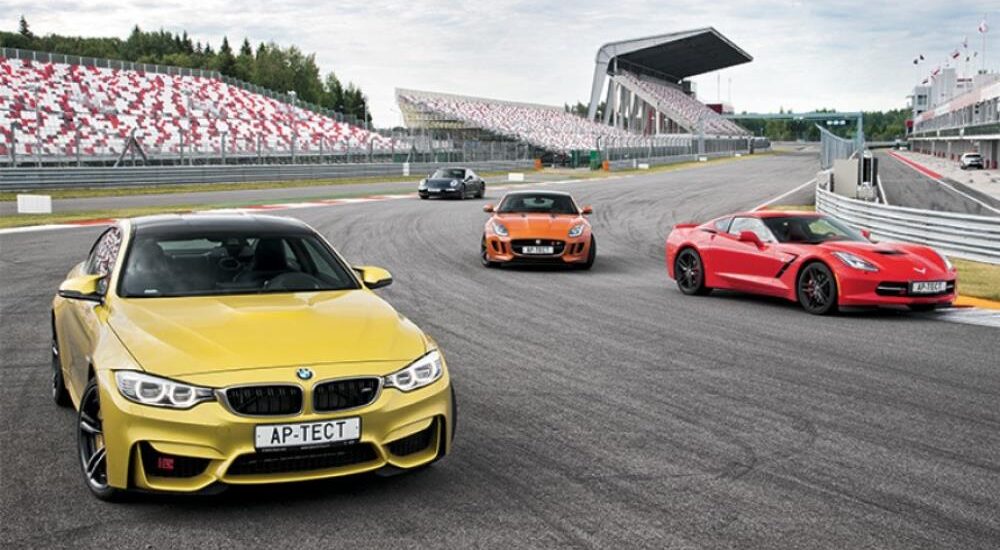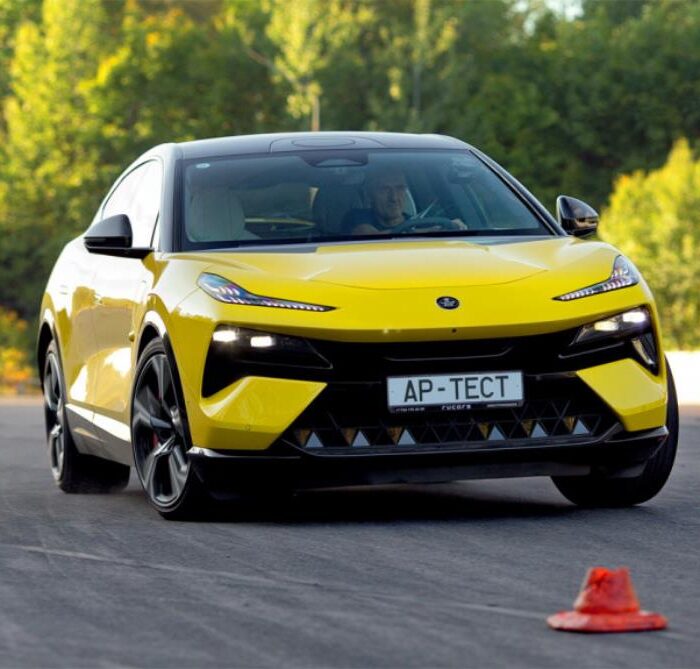Clash of Titans: BMW M4 vs. Porsche 911 vs. Corvette vs. Jaguar F-Type R
After attending the BMW M3/M4 launch in Portugal, I’ve come to recognize a true wizard. Sporting gray hair and standing nearly two meters tall, his tool of choice isn’t a wand but a carbon fiber driveshaft. His name is Albert Biermann, the mastermind behind the new M models. So compelling was Biermann’s presentation, I had no doubts about pitting the BMW M4 coupe against formidable rivals for a comparative test. Indeed, the lighter Porsche 911 Carrera 4S sports all-wheel drive, while the Chevrolet Corvette and the Jaguar F-Type R coupe boast higher power. Yet, I’d wager that on the Moscow Raceway, the M4 will more than hold its ground!

Moscow Raceway (FIM configuration)
The Porsche 911 serves as a kind of benchmark, reminiscent of those special laboratory railway wagons that inspect track conditions on the go. In similar fashion, the 911 surveys the road, capturing every imperfection, its body and steering wheel vibrating continuously. By pulling the door handle, you agree to become a data carrier, slotting yourself into the hard seat and syncing with the reclined steering wheel. You’re then left to select the data transfer volume via two suspension settings. Remember, even Porsche’s “comfort” mode diligently mirrors the road profile, jostling passengers over bumps.
However, the suspension can absorb significant shocks without becoming uncomfortable—allowing you to arrive at the racetrack in high spirits. And on the track…

Porsche 911 – rear-wheel drive or all-wheel drive? To participate in the test, we chose the Carrera 4S version, but at Moscow Raceway we also picked up the monowheel Carrera S. It is 350 thousand rubles cheaper, 70 kg lighter and… Faster! The car slides less with the front axle, is more nimble, lively and “brings” the 4S version half a second per lap. But this is on dry land, but what about in the rain? We were lucky: we repeated the comparison in a rainstorm. And now the Carrera 4S turned out to be faster, but… only by 0.3 s

Alexander Divakov: The reactive action of the Porsche steering does not have adjustments, but it is not necessary: the drive is perfectly tuned
| Porsche 911 4S | |
| 0-250 km/h Lap time | 27,8 s 1 m 54,8 s |
Renowned racer Oleg Kesselman, whom I enlisted as the “official driver,” naturally opts for the sport suspension setting. In this mode, body roll seems to vanish, and the tires claw at the asphalt with desperate tenacity. The Porsche’s responses are the calmest and most transparent. The front tires are the first to yield in corners: the all-wheel-drive Carrera begins to understeer before its rear-wheel-drive counterpart. Yet, this rear-engine coupe lets you boldly brake into turns without overloading the front axle, allowing you to accelerate out of the apex and continuously feel the thrust from shifting the world’s top preselective “robot” PDK gearbox in its most aggressive Sport Plus mode.

There is a strict mood in the Porsche salon.
The 3.8-liter flat-six engine (400 hp, 440 Nm) might fall short in raw output compared to its rivals and despite its lightest weight (1555 kg), its power-to-weight ratio doesn’t lead the pack. Yet, it sprints to 100 km/h in a mere 4.8 seconds, and its superior aerodynamics propel it to a top speed of 286 km/h.

When ordering, hard seats can be exchanged for sports “buckets” (plus 159 thousand rubles). The PCM multimedia system with the same type of buttons clearly requires updating
The gritty growl of the six cylinders cuts off abruptly at 8000 rpm, echoing hollowly off the concrete barriers. Kesselman’s precision is evident: three consistent laps are clocked within tenths of a second—even though the rain had washed away some of the track’s grip.

“Robot” PDK is perhaps the best in the world: auto mode is enough even on the track!

You can choose the stiffness of the suspension and the “degree of anger” of the power unit

With this implementation of the “2+2” formula, few people will want to be “plus second” – these are more likely places for luggage
Next, the Jaguar departs the track with a decidedly un-English roar.

Oleg Keselman: Jaguar is an excellent choice for a gentleman who doesn’t mind having fun on the race track
| Jaguar F-Type R | |
| 0-250 km/h Lap time | 24,1 s 1 m 55,4 s |

The interior of the Jaguar is gloomy, visibility is poor, and attention to detail is spot-on: rubberized climate control handles, a metal seat adjustment control, but plastic steering wheel paddles

Beautiful, comfortable and very hard seats are located below the threshold level – getting out of the Jaguar is not easy
The F-Type, certainly a poser, but the kind that earns its respect. It has worked its way up in the automotive gym, so why not flex the muscle of its supercharged V8, boasting a hefty 550 hp? From a standstill, the vibrant coupe rockets to 100 km/h in just 4.5 seconds! Only past 250 km/h does the acceleration begin to feel somewhat tame, topping out at 303 km/h.

Unlike the Corvette, the V8 is not shifted deeper into the wheelbase, and this results in increased understeer
Then why does the Jaguar lag behind the Porsche in dynamic ratings? Because its eight-speed ZF automatic fears sudden accelerations, hesitating alarmingly after a forceful throttle input, even in sport mode.

Simple scales, primitive columns of coolant temperature and fuel level indicators on a low-resolution screen…

The ZF eight-speed automatic transmission is too soft even in sport mode. Multimedia system – outdated
The coupe’s chassis is notably stiffer than the F-Type Roadster, with more precise responses and smoother handling. However, on rural roads, the steering “awakens,” jittery over imperfections: the Jaguar demands a smoother surface than even the 911. Its excessively stiff steering during parking becomes far less communicative, and while its reactions are sharp, the trajectory through corners can be unsettled by surface irregularities.

The F-Type R and Corvette share a rebellious spirit, but for now the Jaguar is faster and more precise. We’re looking forward to next year’s Corvette Z06 with a 650-horsepower engine and an eight-speed automatic transmission
And then there’s the understeer: the heavy (1809 kg) Jaguar’s cornering limits are lower than those of the Porsche. Yet, its acceleration is exhilarating! According to our VBox Sport measurements, while the Porsche barely exceeded 220 km/h on the track’s straight, the F-Type R surged past 240 km/h! However, its lap time is still six-tenths of a second slower than the Porsche: 1:55.4.

Leonid Golovanov: Stealth bomber! But it’s no longer possible to accurately put the new Corvette into a skid by lightly pressing the gas at the bottom, as happened before
| Chevrolet Corvette Stingray Z51 | |
| 0-250 km/h Lap time | 27,9 s 1 m 58,0 s |
Can the Chevrolet Corvette catch the “nine-eleven”? With its aluminum space frame, composite body panels, and rear-mounted transaxle gearbox, the new Corvette is light (1584 kg), with a nearly balanced weight distribution. The seating is the most extreme: you sink into a snug, comfortable seat even lower than in the Jaguar. Cockpit! A digital dashboard, a massive central tunnel, and a long hood stretching out before you. Albeit, the plastic is simpler and the assembly somewhat sloppy.

A small door, a wide threshold, a huge central tunnel and inexpensive plastic… The Chevrolet Corvette is truly unique! Visibility is better than expected – large exterior mirrors help out

Next to the very tight “mechanics” lever is a rotating washer for selecting modes of the mechatronic chassis
From the first roar of its 6.2-liter naturally aspirated engine (466 hp, 630Nm), I expected drama, but instead, the V8 hums with restrained dignity. Even at full throttle, the sound is muffled, lacking the emotional impact to match its acceleration dynamics.

The famous V8 engines of the fifth generation small block family: direct injection, variable valve timing system and shutdown of half the cylinders. But there are only 16 valves, and their drive is from the bottom. Liter power is only 75 hp/l, but you can use AI-92 gasoline
The Corvette demands effort to accelerate. Not just the clutch is stiff, but the shifter of the seven-speed manual as well—short throws but poor selectivity necessitate a pause to engage gears accurately. And why so many “stretched” gears? The sixth and seventh are explicitly overdrive, for fuel economy. On second gear, you can hit 110 km/h, on third 160 km/h, and fourth nearly reaches 250 km/h on the speedometer.





The configuration of the “digital” panel can be changed, plus there is a projection of basic data onto the windshield
The chassis intrigues: double-wishbone suspensions with transverse composite leaf springs instead of coils. The Corvette is ill-suited for frequent use: it’s uncomfortably stiff, unstable on uneven surfaces, noisy, and the flexible front bumper skirt scrapes over every speed bump.
Little joy on regular roads. So, to the “Track” – and charge ahead, to the race track!

The passenger has his own “climate” remote control, and a button on the door handle unlocks the electric lock – but there is also a lever in case of emergency opening of the door

Chevrolet’s removable roof section has mounts in the trunk

An original find – a hiding place behind the screen of the multimedia system
Don’t get the wrong impression—I’m only discussing one of the five modes of the Corvette’s mechatronic chassis. For everyday driving, “Tour” is recommended, while “Track” sharpens throttle responses, stiffens the suspension to an ironclad level, engages the rear active differential, and makes the Chevrolet aggressively chase the direction of the turned steering wheel! Steering must be judicious to avoid provoking slides. The reaction force reminds me of the Jaguar: not exactly delightful, but eagerly absorbed.
Three valid laps yielded a time of 1:58.0. So far, the Corvette is the third fastest lap, but then the BMW took to the track.

| BMW M4 | |
| 0-250 km/h Lap time | 25,4 s 1 m 57,2 s |
By this time, my initial excitement about the “M” from the Portugal event was fully shared by our experts. Even when faced with the choice of “Porsche or BMW?” Divakov chose the M4. Why? For its absolute dominance and perhaps its permissiveness. Unlike the “nine-eleven,” the M4 does not burden you with racing gear. If you’re not in the mood for racing, you can leave the electronically controlled dampers in comfort mode for a smooth, civilian ride. The cabin is quiet, the trunk spacious, and the cabin comfortably seats four. Moreover, the ergonomics and interior materials are on par with Porsche’s, and after using the proprietary iDrive system, other multimedia systems seem obsolete.

Mikhail Ukhov: The BMW M4 is a sports car of the current DTM era, when there is no need to make a homologation car too sporty – more comfort, more speed
Changed your mood? The “M” features individual settings for every scenario: power steering, throttle response sharpness, gear shift speed, and damper mode. Set the power steering to “comfort” right away, as all other settings overly stiffen it at the expense of feedback. Sadly, the M’s dual-clutch transmission can’t match the PDK’s responsiveness: on the racetrack, you still end up using manual mode and flicking the classy metal paddle shifters behind the wheel.

For a supercar (and the BMW M4 is a true supercar), the interior doesn’t differ enough from the civilian versions. Steering wheel, seats, a couple of personalized overlays… BMW is much more “transparent” than other cars, and possible difficulties when parking are removed by a platoon of all-round cameras
The engine, even after experiencing the wild Jaguar, is remarkable. Although the 0-100 km/h time of 4.9 seconds might not astound, the “M” effortlessly accelerates up to 289 km/h and hits the limiter. With the M Driver’s Package, it’s capped at 280 km/h. Yet, it remains stable even near 300 km/h—a feat not matched by the others. And most notably, the elasticity of this twin-turbocharged six-cylinder engine (431 hp, 550 Nm), and its broad torque band, are impressive.
On this torque plateau, there are theoretical books about mastering car control in a drift. In terms of power slides, the “M” matches the Jaguar!

M4’s chairs are lightweight compared to regular ones, so there are no cushion extensions. Adjustable lateral support could be tighter – it would be better to choose grippy fabric upholstery
When Kesselman switched to the BMW M4, we anxiously awaited the results. Early tests had already demonstrated the excellence of the M4’s chassis, but despite its perfect balance and grip comparable to Porsche, the racer encountered traction issues. Attempts by Mikhail Ukhov, a former Russian champion, to improve the result also did not succeed, gaining only a second.
A stroke of luck helped us figure it out: Roberto Traverso from Pirelli discovered that the Pirelli P Zero tires installed on the BMW were intended for other models: the front for Mercedes, the rear for Jaguar. It turned out that other journalists had worn out the original Michelin Pilot Super Sport tires, and they were replaced with available Pirelli in Moscow marked for other cars. This was not noticeable during tests, but during timed laps on the track, differences in tire characteristics impaired handling. Interestingly, the Jaguar had a similar problem, but it had less impact on its performance.
Upon returning to Moscow, it was not possible to find the right tires, even in Germany there was a shortage, and we had to install Michelin Pilot Super Sport for the aftermarket without conveyor specifications. Is there a difference? Nearly two seconds per lap!

The M DCT “robot” is good, but on the race track it “can’t keep up” – you have to switch to manual mode

Below the tachometer is an indication of the mechatronic chassis settings
For the rerun, we didn’t gather everyone—just the Porsche 911—to compare under consistent track conditions. Little had changed: the Porsche consistently lapped at 1:54.5. And BMW’s best new time? 1:57.2. Yes, the “M” was still two and a half seconds slower than the Porsche, but it was a respectable pace—the previous generation M3 was even slower.

Porsche 911 Carrera 4S

Chevrolet Corvette
Interestingly, the Porsche 911 Carrera 4S is less picky about tires. But the new generation BMW M4 and M3 are extremely sensitive to the correct tires. Remember this: if you take these models to the track on non-native tires, you won’t experience even half of Albert Biermann’s magic.

Jaguar F-Type R
But on regular roads, the magic of the “M” is fully intact, even on the wrong tires. The M4 does not lag in dynamics or emotional appeal behind true supercars, contends with Porsche in handling—plus it offers comfort, spaciousness, versatility… And ultimately, a compelling victory in expert ratings. And even without considering BMW’s practical advantages, it still stands as the leader.

BMW M4
Porsche boasts the best brakes in both measurement results and usability. BMW’s expensive carbon-ceramic discs perform flawlessly, though braking distance increases with non-original tires. Notably, after 5,000 km of regular track days, the lifespan of the brake pads according to the onboard computer decreased from 410,000 km to 180,000 km. The heavy Jaguar is equipped with only two-piston mechanisms but withstands three “combat” laps without overheating signs. The F-Type favors more gripping patches of the mix. This issue is even more pronounced with Chevrolet: when braking from 80 km/h, the Corvette nearly spirals out of control!

Regarding lap times, I believe the “M” with its standard passive suspension and without electronically controlled dampers would show better results, especially on its own tires. However, the greatest triumph of the new “M” and the main credit to Biermann’s magic is that this time, the M4, not the Porsche, received expert recognition.
Nonetheless, on the track, the Porsche 911 still outperforms its competitors. No matter how you tune the inline-sixes or V-shaped eights, the “nine-eleven” remains an unrivaled icon.

The Jaguar F-Type R might not become an icon, but it certainly makes a striking impression, much like the Corvette. Yes, among this company, the American is the noisiest with braking challenges on mixed surfaces but it doesn’t stop it from turning heads and becoming the poster car.

Photo: Stepan Schumacher
Expert group: Alexander Divakov | Andrey Mokhov | Ivan Shadrichev | Yuri Kuznetsov | Yaroslav Tsyplenkov
This is a transaltion. You can read the original article here: BMW M4, Porsche 911 Carrera 4S, Chevrolet Corvette или Jaguar F-Type R?





